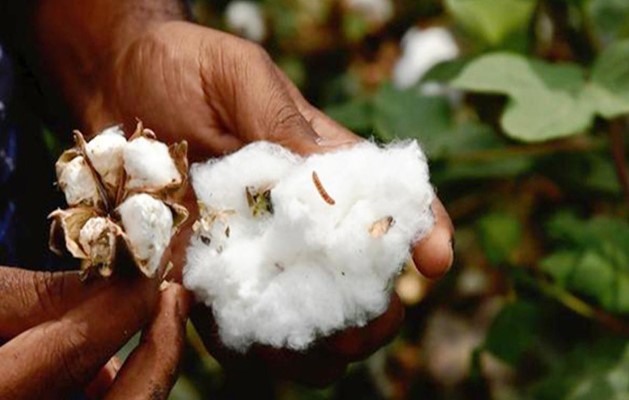- Courses
- GS Full Course 1 Year
- GS Full Course 2 Year
- GS Full Course 3 Year
- GS Full Course Till Selection
- Online Program
- GS Recorded Course
- NCERT (Recorded 500+ Hours)
- Polity Recorded Course
- Geography Recorded Course
- Economy Recorded Course
- AMAC Recorded Course
- Modern India, Post Independence & World History
- Environment Recoded Course
- Governance Recoded Course
- Science & Tech. Recoded Course
- International Relations and Internal Security Recorded Course
- Disaster Management Module Course
- Ethics Recoded Course
- Essay Recoded Course
- Current Affairs Recoded Course
- CSAT
- 5 LAYERED ARJUNA Mentorship
- Public Administration Optional
- ABOUT US
- OUR TOPPERS
- TEST SERIES
- FREE STUDY MATERIAL
- VIDEOS
- CONTACT US
TRANSGENIC CROPS
TRANSGENIC CROPS


Latest Context
Gujarat, Maharashtra, and Telangana recently postponed testing a new type of transgenic cotton seed that contains the gene Cry2Ai, which was authorised by the Centre's Genetic Engineering Appraisal Committee (GEAC).
- According to rumours, the gene Cry2Ai makes cotton resistant to the problematic pink bollworm. The dispute demonstrates that widespread acceptance of genetically modified crops is still difficult.
- Because agriculture is a state subject, companies interested in testing their seeds typically need official clearance before proceeding. Only Haryana granted approval for these tests.
- Telangana asked for more time to think over the idea before responding that experiments would not be permitted during the current harvest season. Gujarat, on the other hand, merely declared the proposition undesirable without giving any justifications.
Facts about Transgenic Crops
- Plants that have modified through genetic engineering techniques are referred to as transgenic crops. In order to give these crops new features or properties that are not naturally found in the species through conventional breeding methods, particular genes have been put into their DNA.
Transgenic Organisms vs GMO:
- Transgenic organism and genetically modified organism (GMO) are two concepts that are frequently used interchangeably.
- GMOs and transgenic organisms differ slightly from one another, though. A transgenic organism is a GMO that contains a DNA sequence or gene from a different species, even if both have changed genomes. An organism that has had its DNA changed via the use of genetic engineering is referred to as a GMO.
- As a result, all transgenic organisms are GMOs, but not all GMOs are transgenic.
Status in India:
- Only cotton is now commercially grown as a GM crop in India. Other crops, including tomato, maize, chickpea, and brinjal, are also undergoing transgenic technology trials.
- The environmental release of the genetically modified (GM) mustard hybrid DMH-11 by the GEAC brought it one step closer to full commercial production.
- The Supreme Court is now hearing a lawsuit that challenges the approval of transgenic food crops. They want for a moratorium on GM mustard because they are worried that farmers would use banned herbicides.
- In the past, the GEAC approved GM mustard in 2017 after more testing, and the government banned GM brinjal indefinitely in 2010.
How Are Genetically Modified Crops Controlled in India?
- Regulation:
- Under the terms of the Environment (Protection) Act of 1986, the Union Ministry of Environment, Forest and Climate Change (MoEFCC) in India is responsible for regulating all GMO-related activities and products.
- All actions, including the import, export, transport, manufacturing, use, or sale of GMOs, are subject to evaluation, monitoring, and approval by the MoEFCC's Genetic Engineering Appraisal Committee (GEAC).
- The commercial growing of genetically modified mustard was just approved by GEAC.
- The Food Safety and Standards Act of 2006 mandates that the Food Safety and Standards Authority of India (FSSAI) regulate GM foods.
- Rules and Acts that Regulate GM Crops in India:
- GM policy under Foreign Trade Policy, Food Safety and Standards Act, 2006.
- Drugs and Cosmetics Rule (8th Amendment), 1988.
- Environment Protection Act, 1986 (EPA).
- Biological Diversity Act, 2002.
- Plant Quarantine Order, 2003.
What is the procedure in India for regulating transgenic crops?
- Transgenic genes are inserted into plants to produce transgenic crops that have a long-lasting, defensive response.
- A combination of science and chance is used in the procedure.
- Before open field tests, committees undertake safety evaluations.
- At agricultural universities or plots under the authority of the Indian Council for Agricultural Research (ICAR), open field experiments are conducted.
- For commercial approval, transgenic plants must be superior to non-GM varieties and ecologically safe.
- Open field tests evaluate adaptability in a variety of climates and geographical conditions.
Importance of Genetic Modification (GM) Technique
- Affordable and Safer Vaccines: The GM has transformed the pharmaceutical industry by making it possible to produce treatments and vaccines that are safer and cheaper. It has made it easier to mass produce life-saving medications such human insulin, vaccinations, and growth hormones, increasing their accessibility.
- Regulate Weeds: The development of crops that are resistant to herbicides has also been greatly aided by GM technology. The ability to tolerate particular broad-spectrum herbicides has been genetically engineered into crops including soybean, maize, cotton, and canola. This enables farmers to successfully manage weeds while protecting the cultivated crop.
- Providing Food Security: In order to respond to shifting environmental circumstances, GM crops are being produced. To ensure food security in harsh regions, scientists are developing strains of rice, maize, and wheat that can withstand longer droughts and wetter monsoon seasons.
- Solution for Growing Crops in Salty Oils: GM has also been utilised to develop salt-tolerant plants, providing a potential answer for cultivating crops in soils with high levels of salt. Plants may grow in high-salt settings by introducing genes that remove sodium ions from water and preserve cell equilibrium.
Problems related to Transgenic Crops
- Low Nutritional Value: Despite their enhanced output and concentration on pest resistance, GM crops can lack nutritional value. This is due to the fact that nutritional value is sometimes overlooked in favour of increasing particular features.
- Risks to Ecosystems: Ecosystems and biodiversity may potentially be at danger as a result of GM production. Long-term loss of variety might result from it damaging indigenous types and interfering with gene flow.
- Trigger Allergic Reactions: Given that they are physiologically transformed, foods that have undergone genetic modification may cause allergic responses. For someone used to traditional types, this may be an issue.
- Endangered Animals: The harm posed by GM crops extends to wildlife. For examples, animals like mice or deer who ingest crop trash left in fields after harvest might be put in risk by genetically engineered plants used to make plastic or medicines.
Way Forward
- For the benefit of both domestic and international customers, the regulatory framework has to be enhanced in light of recent advancements.
- Science-based judgements must be adopted, and technology clearance processes must be expedited.
- To guarantee that safety measures are carefully followed and to stop the spread of unauthorised GM crops, stringent monitoring and enforcement are required.

Prelims
Q1. Other than resistance to pests, what are the prospects for which genetically engineered plants have been created? (2012)
- To enable them to withstand drought.
- To increase the nutritive value of the produce.
- To enable them to grow and do photosynthesis in spaceships and space stations.
- To increase their shelf life.
Select the correct answer using the codes given below:
a) 1 and 2 only
(b) 3 and 4 only
(c) 1, 2 and 4 only
(d) 1, 2, 3 and 4
Ans: (c)
Q2. Bollgard I and Bollgard II technologies are mentioned in the context of (2021)
(a) clonal propagation of crop plants
(b) developing genetically modified crop plants
(c) production of plant growth substances
(d) production of biofertilizers
Ans: (b)
Mains
Q. How can biotechnology help to improve the living standards of farmers? (2019)



